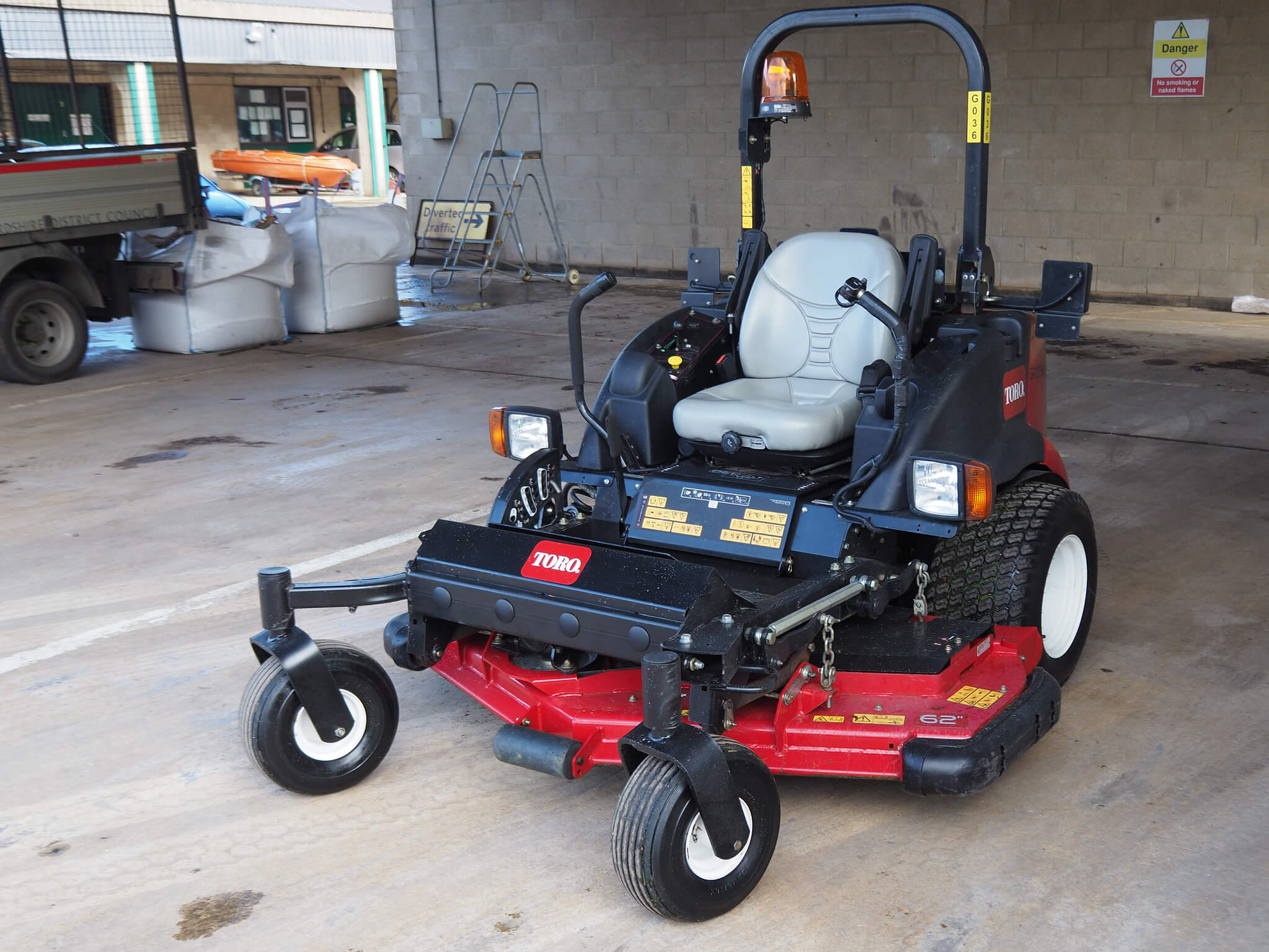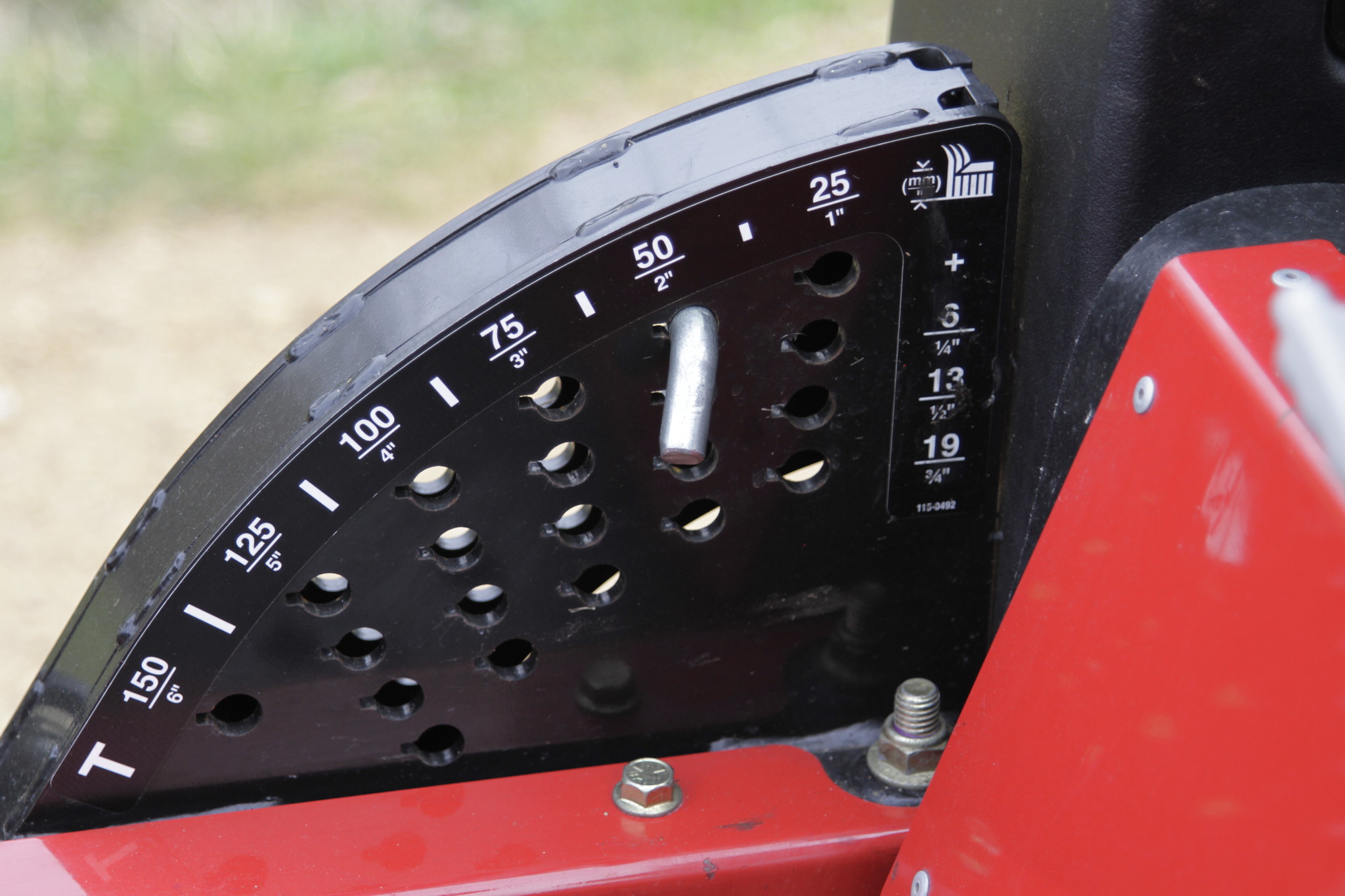Toro Groundsmaster 7210
Zero-turn mowers have distinct individual characteristics.
Some models are sensitive to modest control inputs, endowing them with a nippy manoeuvrability with the drawback of taking some time to master. Others have a more laboured need for input into the control levers, making it easier to keep the mower driving in a straight line, but perhaps more tiring to use in repeated fast manoeuvres.

Containing clippings is a real plus when working close to paved areas and preventing debris getting blown onto walls.
First impressions
Take the seat on a Groundsmaster 7210, start it up and you feel Toro has got the control balance pretty much spot on. Even those more used to a steering wheel will settle into working the steering levers of a Groundsmaster. It, of course, takes practice to deliver tight, turf-friendly turns, but working close to obstacles and placing the mower accurately when following a line is perhaps easier on a GM7210 than on some existing zero-turn alternatives.
When it comes to mowing finish, the 1.57m deck of the test Groundsmaster 7210 not only contained clippings well it also deposited them evenly across the width of the deck, meaning the fitted Guardian Recycler system was doing its job on the first short cut of the season. Long grass and litter to cope with? No problem, Toro has a deck to suit including an articulated 2.54m unit for wide-area mowing. Who says a zero-turn can’t be versatile in its applications?

The ability to work up close to awkwardly spaced shrubs and obstacles can reduce the need for a pedestrian mower to finish certain jobs.

The ability to work up close to awkwardly spaced shrubs and obstacles can reduce the need for a pedestrian mower to finish certain jobs.
Put to the test
Those who know their mowers will perhaps wonder why Toro has appeared not to push its zero-turn Groundsmaster GM7200 and GM7210 models harder. Targeting commercial users looking for dependable and economical diesel engine performance, both the three-cylinder Kubota power units in the GM7200 and GM7210 certainly offer the promise of decent performance.
So, what’s the difference between the models? The 25hp naturally aspirated engine deployed in the 7200 has enough power to drive either a 1.52 and 1.83m side-discharge or 1.57 and 1.83m base decks with Guardian Recycler system. This ability keeps clippings contained and leaves a fine finish. The turbo-charged GM7210 on the other hand develops to a meaty 35hp, enabling this model to drive a wide, grass-gobbling, 2.54m rear discharge deck.
Fitted articulated outer wing sections, with separate depth wheels front and rear, the five rotor 2.54m deck will suit those seeking to mow wider areas, with plus or minus 15 degrees of movement enabling the wings to cleanly mow undulating terrain. Those tasked with tending parkland with numerous trees and obstacles to mow around should take a serious look at the high output potential of this wide GM7210 variant.

Height of cut is set by a simple ‘pin and hole’ system, the lower holes allowing incremental heights to be chosen between the main settings of between 25 to 150mm.

Raising the one-piece engine hood provides good service access. The large air filter is easy to get at, as is the battery and oil level dipstick.
For longer grass, and working in less than ideal conditions, a side-discharge deck will have a clear appeal. Purposely developed to provide a clean cut, these decks are well suited to dealing with mid-season grass heading, taking over intermediate mowing from cylinder mower models that can struggle to trim longer stems. Where grass mowing budgets are under pressure, a GM7200 / GM7210 and side-discharge deck could well provide a highly productive cut and ‘drop choice’ to cover both wider verge and more involved amenity mowing.
Toro is, however, widely connected with mowers that deliver a high-quality cut and excellent finish. Try a deck with the Guardian Recycler system and it is understandable why this type of deck is tempting those tasked with delivering a cylinder quality mow on a rotary mower budget. Even in damp conditions, the finish left by the demo GM7210 fitted with the 62inch 1.57m deck was impressive.
Of equal importance, the clippings were completely contained within the deck, allowing mowing right up close to paved areas without any discharge of clippings. An added plus is that this type of deck should also contain material that could potentially fly out from the deck and cause third-party damage.

Meaty rubber guards at the deck edge provide scuff protection for street furniture, tree trunks and walls. The heavy gauge decks are designed for commercial operation, a ‘bull- nose’ solid steel bumper on the leading edge helps protect from damage.

Simple chart on side console cubby lid lists key daily check points and service intervals – note the mechanical fuel gauge. Just out of shot is the recessed fuel cap, the design helps prevent accidental fuel spills contaminating platform.
Downside? You cannot have everything with a deck designed to contain and finely chop into clippings. Tackle overly long, wet grass and expect a single pass to trim to the contract mowing height and it may not work out. For wet grass, the trick is little and often mowing or doing a couple of passes over long grass, the second trim delivering the required height-of-cut.
Working these diminutive mowers is simple. The cut height is set via the established Toro ‘hole and pin’ system. The steering levers take care of the direction of travel and bring the machine to a stop. When raised, the deck has a useful 203mm of clearance, thus enabling an 8inch curb to be mounted without the risk of damage.
In tight spots, it is of course the manoeuvrability of these machines that really stands out. To suggest you can tuck a mower of this size into the small areas typically tackled by a pedestrian model is of course misleading, but just how much can be mown by a zero-turn can be a surprise. Again, opting for a zero-turn on the mowing fleet can be an effective way of reducing overall mowing costs.

Simple controls and easy set-up will make new operators feel at ease with the mower. Road legal light and warning beacon kits can be fitted for highway operation. Top mow and transport speed are limited to 20km/h.

Drive is taken via a shaft to the deck, with belts transmitting power to the cut rotors. Note easy access to the belt tensioners and grease points.
Conclusion
When it comes to innovation you only have to take a good look at how the GM7210 is put together. Service access has clearly been a design priority, the locking engine cover, flip-up seat and foot panel to access the deck drive fold out of the way so you can get to key routine check and lube points easily. The engine air filter is large and draws ‘clean’ air from a point above the engine. In dusty conditions, it should have the capacity to protect the engine without repeated checks and cleaning.
While on the durability front, the strength of the mower is further reflected in the quality of the welds, thickness of the deck steel and depth of paint.
In summary
Commercial mowers lead a hard life and the GM7210 looks tough enough to take it. The mower ultimately tested well for performance and pleasingly delivered a quality finish too.
Specification
Engine type: Kubota liquid-cooled diesel
Engine size: (hp/kW) 24.8hp (18.5 kW)
Cutting width (cm): 158 or 183
Cutting deck: 7-Gauge welded steel
Transmission: Integrated direct drive
Lift: Hydraulic deck lift
